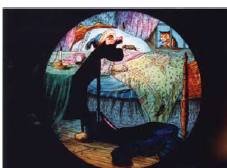Ernie Gerh - Panoramas of the Moving Image
dal 11/9/2007 al 23/3/2008
Segnalato da
11/9/2007
Ernie Gerh - Panoramas of the Moving Image
The Museum of Modern Art - MoMA, New York
Mechanical Slides and Dissolving Views from Nineteenth-Century Magic Lantern Shows. Painted or printed images on glass were among the earliest forms of projected motion picture entertainment. Experimental media artist Ernie Gehr's work is a ynchronized video installation that uses 87 original slides and views selected from Gehr's personal collection and that of renowned pre-cinema collector David Francis.

Mechanical Slides and Dissolving Views from Nineteenth-Century Magic Lantern Shows
Painted or printed images on glass were among the earliest forms of
projected “motion picture” entertainment. Mechanical glass slides were
manipulated to simulate various kinds of change in the image, and multiple
projectors allowed for superimposed and dissolving views. Brightly
colored, handcrafted slides, depicting human activity, fantasy figures, and
landscapes, were typically presented with live narration, music, and sound
effects, in what became popular by the 1870s as Magic Lantern shows.
Experimental media artist Ernie Gehr’s Panoramas of the Moving Image
(2005) is a synchronized five-channel video installation that uses 87
original slides and views selected from Gehr's personal collection and that
of renowned pre-cinema collector David Francis. Projected side by side, the
slides create a mesmerizing wide-screen spectacle. A selection of vintage
paper Zoetrope strips and Phenakistoscope discs-complementary artifacts
of nineteenth-century moving-image technology-are also on display.
Organized by Jytte Jensen, Curator, and Ron Magliozzi, Assistant Curator,
Research and Collections, The Museum of Modern Art.
Opening september 12 2007
The Museum of Modern Art - MoMa
11 West 53 Street - New York



